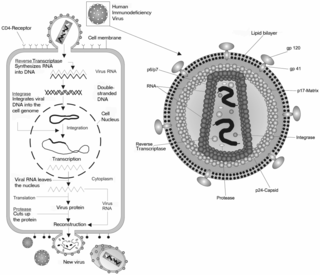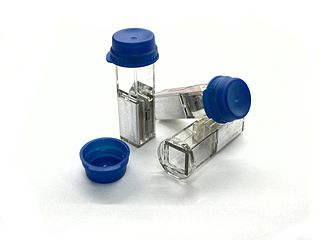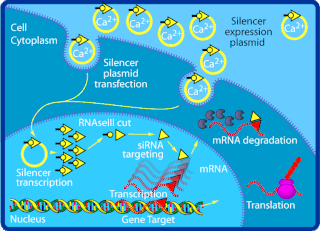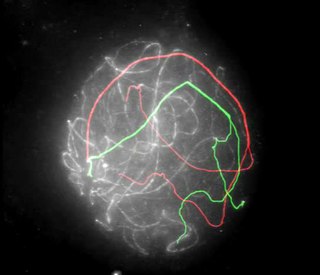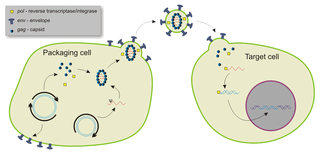Methods
There are various methods of introducing foreign DNA into a eukaryotic cell: some rely on physical treatment (electroporation, cell squeezing, nanoparticles, magnetofection); others rely on chemical materials or biological particles (viruses) that are used as carriers. There are many different methods of gene delivery developed for various types of cells and tissues, from bacterial to mammalian. Generally, the methods can be divided into three categories: physical, chemical, and biological. [5]
Physical methods include electroporation, microinjection, gene gun, impalefection, hydrostatic pressure, continuous infusion, and sonication. Chemicals include methods such as lipofection, which is a lipid-mediated DNA-transfection process utilizing liposome vectors. It can also include the use of polymeric gene carriers (polyplexes). [6] Biological transfection is typically mediated by viruses, utilizing the ability of a virus to inject its DNA inside a host cell. A gene that is intended for delivery is packaged into a replication-deficient viral particle. Viruses used to date include retrovirus, lentivirus, adenovirus, adeno-associated virus, and herpes simplex virus.[ citation needed ]
Physical methods

Physical methods are the conceptually simplest, using some physical means to force the transfected material into the target cell's nucleus. The most widely used physical method is electroporation, where short electrical pulses disrupt the cell membrane, allowing the transfected nucleic acids to enter the cell. [5] Other physical methods use different means to poke holes in the cell membrane: Sonoporation uses high-intensity ultrasound (attributed mainly to the cavitation of gas bubbles interacting with nearby cell membranes), optical transfection uses a highly focused laser to form a ~1 μm diameter hole. [7]
Several methods use tools that force the nucleic acid into the cell, namely: microinjection of nucleic acid with a fine needle; [5] biolistic particle delivery, in which nucleic acid is attached to heavy metal particles (usually gold) and propelled into the cells at high speed; [8] and magnetofection, where nucleic acids are attached to magnetic iron oxide particles and driven into the target cells by magnets. [8]
Hydrodynamic delivery is a method used in mice and rats, in which nucleic acids can be delivered to the liver by injecting a relatively large volume in the blood in less than 10 seconds; nearly all of the DNA is expressed in the liver by this procedure. [9]
Chemical methods
Chemical-based transfection can be divided into several kinds: cyclodextrin, [10] polymers, [11] liposomes, or nanoparticles [12] (with or without chemical or viral functionalization. See below).
- One of the cheapest methods uses calcium phosphate, originally discovered by F. L. Graham and A. J. van der Eb in 1973 [13] (see also [14] ). HEPES-buffered saline solution (HeBS) containing phosphate ions is combined with a calcium chloride solution containing the DNA to be transfected. When the two are combined, a fine precipitate of the positively charged calcium and the negatively charged phosphate will form, binding the DNA to be transfected on its surface. The suspension of the precipitate is then added to the cells to be transfected (usually a cell culture grown in a monolayer). By a process not entirely understood, the cells take up some of the precipitate, and with it, the DNA. This process has been a preferred method of identifying many oncogenes. [15]
- Another method is the use of cationic polymers such as DEAE-dextran or polyethylenimine (PEI). The negatively charged DNA binds to the polycation and the complex is taken up by the cell via endocytosis.
- Lipofection (or liposome transfection) is a technique used to inject genetic material into a cell by means of liposomes, which are vesicles that can easily merge with the cell membrane since they are both made of a phospholipid bilayer. [16] Lipofection generally uses a positively charged (cationic) lipid (cationic liposomes or mixtures) to form an aggregate with the negatively charged (anionic) genetic material. [17] This transfection technology performs the same tasks as other biochemical procedures utilizing polymers, DEAE-dextran, calcium phosphate, and electroporation. The efficiency of lipofection can be improved by treating transfected cells with a mild heat shock. [18]
- Fugene is a series of widely used proprietary non-liposomal transfection reagents capable of directly transfecting a wide variety of cells with high efficiency and low toxicity. [19] [20] [21] [22]
- Dendrimer is a class of highly branched molecules based on various building blocks and synthesized through a convergent or a divergent method. These dendrimers bind the nucleic acids to form dendriplexes that then penetrate the cells. [23] [24]
Viral methods
DNA can also be introduced into cells using viruses as a carrier. In such cases, the technique is called transduction, and the cells are said to be transduced. Adenoviral vectors can be useful for viral transfection methods because they can transfer genes into a wide variety of human cells and have high transfer rates. [2] Lentiviral vectors are also helpful due to their ability to transduce cells not currently undergoing mitosis.
Protoplast fusion is a technique in which transformed bacterial cells are treated with lysozyme in order to remove the cell wall. Following this, fusogenic agents (e.g., Sendai virus, PEG, electroporation) are used in order to fuse the protoplast carrying the gene of interest with the target recipient cell. A major disadvantage of this method is that bacterial components are non-specifically introduced into the target cell as well.
